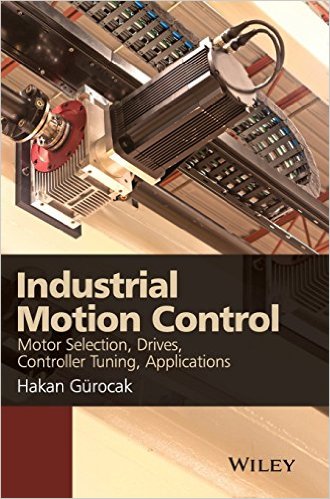 [内容简介]
[内容简介]
Motion control is widely used in all types of industries including packaging, assembly, textile, paper, printing, food processing, wood products, machinery, electronics and semiconductor manufacturing. Industrial motion control applications use specialized equipment and require system design and integration. To design such systems, engineers need to be familiar with industrial motion control products; be able to bring together control theory, kinematics, dynamics, electronics, simulation, programming and machine design; apply interdisciplinary knowledge; and deal with practical application issues.
The book is intended to be an introduction to the topic for senior level undergraduate mechanical and electrical engineering students. It should also be resource for system design engineers, mechanical engineers, electrical engineers, project managers, industrial engineers, manufacturing engineers, product managers, field engineers, and programmers in industry.
[目录]
Preface ix
1 Introduction 1
1.1 Components of a Motion Control System 3
1.1.1 Human–Machine Interface 3
1.1.2 Motion Controller 4
1.1.3 Drives 6
1.1.4 Actuators 7
1.1.5 Transmission Mechanisms 7
1.1.6 Feedback 7
References 9
2 Motion Profile 11
2.1 Kinematics: Basic Concepts 11
2.2 Common Motion Profiles 15
2.2.1 Trapezoidal Velocity Profile 15
2.2.2 S-curve Velocity Profile 21
2.3 Multiaxis Motion 28
2.3.1 Slew Motion 28
2.3.2 Interpolated Motion 29
Problems 30
References 34
3 Drive-Train Design 35
3.1 Inertia and Torque Reflection 36
3.1.1 Gearbox Ratio 36
3.1.2 Reflected Inertia 38
3.1.3 Reflected Torque 39
3.1.4 Efficiency 39
3.1.5 Total Inertia 40
3.2 Inertia Ratio 41
3.2.1 Targeted Practical Inertia Ratio 43
3.3 Transmission Mechanisms 43
3.3.1 Load and Inertia Reflection through Transmission Mechanisms 44
3.3.2 Pulley-and-Belt 45
3.3.3 Lead Screw 47
3.3.4 Rack-and-Pinion Drive 52
3.3.5 Belt-Drive for Linear Motion 53
3.3.6 Conveyor 54
3.4 Torque Required for the Motion 56
3.4.1 Acceleration (Peak) Torque 57
3.4.2 Running Torque 57
3.4.3 Deceleration Torque 58
3.4.4 Continuous (RMS) Torque 58
3.5 Motor Torque–Speed Curves 62
3.5.1 Torque–Speed Curves for AC Servomotors 63
3.5.2 Torque–Speed Curves for AC Induction Motors 64
3.6 Motor Sizing Process 67
3.7 Motor Selection for Direct Drive 68
3.8 Motor and Transmission Selection 69
3.9 Gearboxes 72
3.9.1 Planetary Servo Gearheads 72
3.9.2 Worm Gear Speed Reducers 73
3.10 Servo Motor and Gearhead Selection 75
3.11 AC Induction Motor and Gearbox Selection 89
3.12 Motor, Gearbox, and Transmission Mechanism Selection 96
Problems 100
References 105
4 Electric Motors 107
4.1 Underlying Concepts 107
4.1.1 Electrical and Mechanical Cycles 109
4.1.2 Three-Phase Windings 110
4.2 Rotating Magnetic Field 110
4.2.1 Hall Sensors 110
4.2.2 Six-Step Commutation 111
4.3 AC Servo Motors 114
4.3.1 Rotor 114
4.3.2 Stator 115
4.3.3 Sinusoidal Commutation 119
4.3.4 Torque Generation with Sinusoidal Commutation 123
4.3.5 Six-Step Commutation of AC Servo Motors 124
4.3.6 Motor Phasing with Encoders and Hall Sensors 125
4.4 AC Induction Motors 126
4.4.1 Stator 126
4.4.2 Rotor 127
4.4.3 Motor Operation 128
4.4.4 Constant Speed Operation Directly Across-the-Line 129
4.4.5 Variable Speed Operation with a VFD 131
4.5 Mathematical Models 132
4.5.1 AC Servo Motor Model 134
4.5.2 AC Induction Motor Model 140
Problems 145
References 146
5 Sensors and Control Devices 148
5.1 Optical Encoders 148
5.1.1 Incremental Encoder 149
5.1.2 SinCos Encoders 152
5.1.3 Absolute Encoder 154
5.1.4 Serial Encoder Communications 157
5.1.5 Velocity Estimation 160
5.2 Detection Sensors 162
5.2.1 Limit Switches 162
5.2.2 Proximity Sensors 162
5.2.3 Photoelectric Sensors 163
5.2.4 Ultrasonic Sensors 164
5.2.5 The Concept of Sinking and Sourcing 165
5.2.6 Three-Wire Sensors 167
5.3 Pilot Control Devices 168
5.3.1 Push Buttons 169
5.3.2 Selector Switches 170
5.3.3 Indicator Lights 170
5.4 Control Devices for AC Induction Motors 171
5.4.1 Motor Control Circuit 172
Problems 174
References 175
6 AC Drives 177
6.1 Drive Electronics 177
6.1.1 Converter and DC Link 178
6.1.2 Inverter 180
6.2 Basic Control Structures 188
6.2.1 Cascaded Velocity and Position Loops 188
6.2.2 Single-Loop PID Position Control 192
6.2.3 Cascaded Loops with Feedforward Control 201
6.3 Inner Loop 207
6.3.1 Inner Loop for AC Induction Motors 209
6.3.2 Inner Loop for AC Servo Motors 210
6.4 Simulation Models of Controllers 210
6.4.1 Simulation Model for Vector Control of an AC Induction Motor 211
6.4.2 Simulation Model for Vector Control of an AC Servo Motor 215
6.5 Tuning 215
6.5.1 Tuning a PI Controller 219
6.5.2 Tuning a PID Position Controller 223
6.5.3 Tuning a Cascaded Velocity/Position Controller with Feedforward Gains 232
Problems 242
References 245
7 Motion Controller Programming and Applications 247
7.1 Move Modes 247
7.1.1 Linear Moves 248
7.1.2 Circular Moves 248
7.1.3 Contour Moves 248
7.2 Programming 249
7.2.1 Motion Programs 250
7.2.2 PLC Functionality 250
7.3 Single-Axis Motion 253
7.3.1 Jogging 254
7.3.2 Homing 254
7.4 Multiaxis Motion 256
7.4.1 Multiple Motors Driving One Axis 256
7.4.2 Coordinated Motion of Two or More Axes 257
7.4.3 Following Using Master/Slave Synchronization 258
7.4.4 Tension Control 273
7.4.5 Kinematics 278
Problems 284
References 288
Appendix A Overview of Control Theory 289
A.1 System Configurations 289
A.2 Analysis Tools 289
A.2.1 Transfer Functions 291
A.2.2 Block Diagrams 292
A.3 Transient Response 293
A.3.1 First-Order System Response 293
A.3.2 Second-Order System Response 293
A.4 Steady-State Errors 297
References 298
Index 299

 新书报道
新书报道